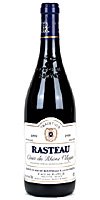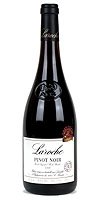...so then Pinot Noir goes to Grenache: You bring me downstream


Here we have a wine made from Pinot Noir and a Côte du Rhône wine. I'm putting them in the same review because, like a Sancerre to goat's cheese, there's an interesting relationship going on. The Sauvignon Blanc in a Sancerre is said to complement goat's cheese with its high acidity and contrast it too by adding something in the herbal department. It's a nice dynamic and my putting these two wines together attempts something along those lines. Like the shared acidity in the above equation, each wine possesses a common denominator in climate: They were both rendered out of the Midi in the late summer of 2003. And as for contrast, what could establish a greater gap than comparing the humble descriptive record of Grenache to the storied accomplishments of Pinot Noir. In my mind, placing these two bottles back-to-back would surely be enlightening. Where do varietal characteristics end and terroir influences begin? And though these were not cultivated from the same vineyard, they do share a certain regional profile. And I wanted to investigate that profile by tasting the wine grape I least respect right after the one I most revere.
The Cave de Rasteau, Côtes du Rhône-Villages 2003 is composed mostly of Grenache grapes. That's really my problem, not the wine's. Because Rhône appellations enforce vintners to include at least 40% Grenache in their reds, I end up a tough sell. On top of that, I tend to avoid shopping for Rhônes because it seems someone has always brought one out to dinner anyway. I guess when I get right down to it, Grenache, in general, is not a variety I harbour great affinity for. I sometimes detect a sweetness there that unfortunately reminds me of the sweetening agent in children's cherry medicine. But that is personal reaction and of course it doesn't apply in every case. I suspect I'm drawing my stereotype from low-end Rhônes. And I hate to say I dislike Grenache because it really is simply not true. Once in a while I'll be transported by a Grenache-led blend. This happens more often when I spend $20-plus, like in the wonderfully smooth case in point provided by the 2000 Antique Senimaros from Cave de Cairanne. For about $5 more than this Rasteau here, you will be invited to experience the difference that a higher-end Rhône can carry. And it's a difference that my money is on. Because it may be my palate is too temperamental -- a slight bit too much in the cherry department (something that so many of my friends encourage) just comes off as cloying to me. It sends my wine appreciation meter exponentially low. I hazard that's what you would call a classic case of dislike.
So needless to say this Rasteau had a lot to live down. But it manages quite well for itself. It enchants with its hearty balance and richness, neither characteristic overly fruity. Not fruit-bomb-y -- perhaps that's more to the point. Vaucluse, France. 14%.
Surprisingly, my tasting notes mark very similar reactions for the Pinot. The Laroche Pinot Noir Vin de Pays d'Oc 2003 is juicy, round and refreshing. It delivers bracing cherry notes in a way I would expect a Rhône to, but with much lighter body. An aroma of ripe blueberry tells you that you are not dealing with Grenache anymore. Its nose is good; its balance, not subtle, is punctuated by firm tannins. It's the depth that is most lacking, but quite fine as an everyday selection. Great with roast beef too. Béziers, France. 12.5%.
Conclusion: This potential odd couple share a ripened fruitiness that transcends the different grapes varieties of which they are made.
Backwash
It's seems like Montreal newspapers are covering their tracks. The leads they had with their liquor board price fixing story are quickly being replaced by newer articles clearly driven by SAQ press releases. So with that in mind, here is the original item that started it all (in French) and here is a comparable piece about the story written in English. In yesterday's space the CBC story did a fair job summarizing the whole conundrum. This one does okay too, but it really does feel shadier than a palm grove walking into an SAQ lately. I still want more brought to light regarding this one. A great -- if opinionated and French -- resource for a whole history of unyielding criticism towards the SAQ is found at this blogue. I'll be watching it and hoping for more in the meantime.







No comments:
Post a Comment